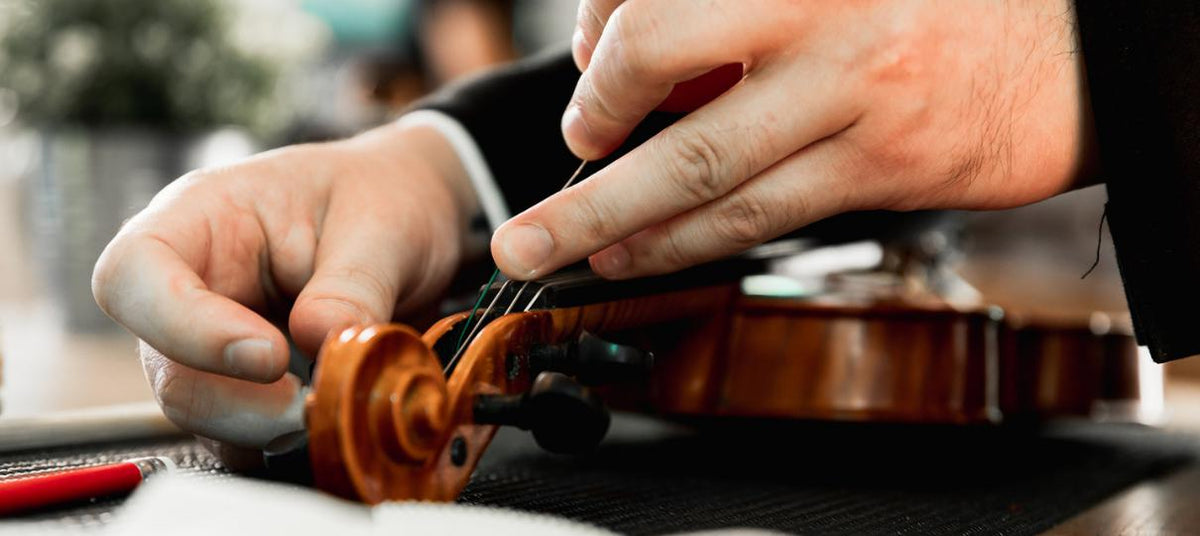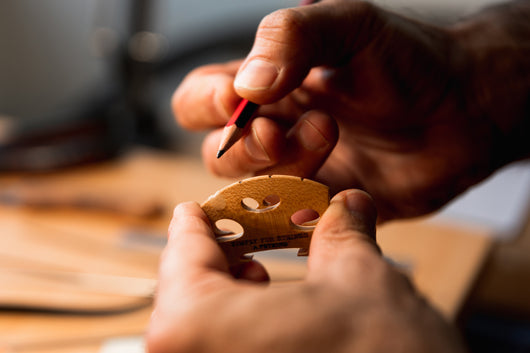How to Successfully Change Strings on Your Violin, Viola, Cello and Double Bass (Without Breaking Them!)

Want an in-depth guide to changing strings on your violin, viola, cello or double bass? We asked one of our team members Michael to share with us his top tips for replacing strings. This blog post is filled with some great tips and tricks to make sure you’re looking after your new strings and of course, your instrument!
Warning: this looks long and involved, but in reality the process is quite short. Once you get the hang of it, you’ll be surprised by how quickly you’ll be fitting strings to your instrument!
Everybody knows how to change strings, don’t they? Why am I writing yet another “how to”? Isn’t it all just common sense? I’ve been changing my own strings since my teacher showed me how in 1974, usually with the expected success. I’m sure you also know what you’re doing.
A decent set of violin strings will cost well over $100 and several sets are now pushing toward $300. Viola strings cost more than violin. A good set of cello strings is likely to start at $400 and many sets are now well over $600 and $700. Not to mention double bass! We need to get the best performance and lifespan out of our strings.
I know the list below is quite long, and seems very involved. But stick with me! You may learn some things you didn’t know, saving yourself time and money in the long run. There are many steps here, but if you are aware of these factors you’ll know how to keep an eye on the health of your instrument and strings.
If you take note of these points and inspect your instrument now, the process of changing strings next time can still be quite fast. Our specialist staff members can change a set of strings in less than two minutes. It doesn’t hurt to be patient and give a quick check over the instrument beforehand, and the process is still not as time-consuming as this article might make it appear!

Before you begin
Why are you changing your strings? Do you have a broken string? Is it time to replace them? (strings deteriorate with time and usage) Wanting a different sound or other characteristics? Wolf tone issues?
Knowing why you’re changing your strings means you can prepare properly.
Preparation
Firstly, check the new strings for obvious faults before you install them. String manufacturers do not provide a warranty on strings once they have been fitted to an instrument.
Check for faults along the length of the string and check the ends, under the silk winding, the loop and ball. If there is anything out of the ordinary at this stage, stop, and go back to place of purchase to see if the string is indeed faulty.
Next up, checking the condition of your instrument.
The Bridge
Ensure the bridge isn’t bending, and that the feet are sitting fully flush on the surface of your instrument. If the bridge isn’t, chances are it will fall over as you begin to remove or replace strings, and you could accidentally injure your instrument.
If you’ve purchased your instrument from a reputable store, the bridge will have been fitted prior to sale to ensure it is correctly shaped and fitted to your instrument. However, it is a good idea to check the shape of the bridge itself and the depth of the string grooves in the case that you’ve been experiencing a lot of string breakages. If the string grooves are too deep, or the height of the strings on the fingerboard is too high, chances are that’s why you’re experiencing string breakages. Stop at this point and come visit us instead! We can assess your instrument and bridge and see if it requires attention from a luthier.
The Nut
Check the condition of your nut by examining the shape and depth of the grooves. Is any string sitting so low at the nut that it touches the fingerboard? If it buzzes when you pluck an open string, the groove is too low. If you’ve been experiencing string breakages at the nut, it may mean you need servicing on your instrument to ensure that doesn’t continue to occur.
The Pegs
Are the current strings sitting well away from the sides of the peg box? If the string hole is too close to the side of the peg box, the string can jam against the side, stopping the peg from holding securely in tune. Are the pegs smoothed off at the sides of the holes? Sharp edges can damage your strings.
If you’re a double bassist, make sure the machine heads are functioning correctly and that they are turning with ease.
The Tailpiece
Check the fine adjusters. Make sure they are working properly and loosen them up nearly all the way to help with tuning afterwards. You might also wish to lubricate them at this stage with something like WD40. You’ll need the tiniest amount.

Changing the Strings
Firstly, tune the violin, viola or cello to approximately correct using the pegs. If you’re a bassist, do this with the machine heads! This makes it easier to tune when fitting each string, if the other strings are in tune.
Next up, remove the old string and clean the fingerboard underneath the area covered by that string with a soft microfibre cloth.
Then, check the condition of the peg.
If it’s dirty, wipe clean by holding a cloth firmly around the shaft and turning the handle back and forth. If it’s really dirty or uneven, clean it with “superfine” steel wool (bought from a hardware store - in the paint section) to smooth it out.
Apply peg paste to the sections of peg that make contact with the pegbox holes. Here in our Queensland climate, we find Hills Peg Paste works best.
Then, inspect the grooves on bridge and nut. The string should be able to slide through the groove, unrestricted by burrs in the wood. The string should be able to slide through the groove, not pinched by a groove that is too tight. The groove should also not be too wide.
The bottom third of the string should just fit nice and snug in the groove with the remaining two-thirds sitting about the nut and bridge. This allows the string to vibrate freely, and to transmit sound effectively through the nut and bridge. Ideally one third of the string sits in the groove: tolerance is between 30% and 50%. The grooves should be nicely finished at each end, with no sharp edges to damage the string.
Then, line the grooves liberally with graphite (pencil). This lubricates the groove and helps protect the string from damage as it drags over the wood. It also helps protect the wood: strings will cut into the timber over time.
Next, start fitting the new string into the peg hole or machine head.
When inserting the string into the string hole on the peg, just have a small amount protruding on the other side. Too much overhang could scratch the pegbox and possibly damage neighbouring strings. Too little and the string could pull out while you’re tuning. Holding the string tight, turn the peg so the string goes over the top.
When winding the string onto your peg, keep the winds neatly next to each other. You can start by winding the string on the “wrong” side of the hole if you wish, and then cross back over itself neatly to create a sort of knot. Ensure the string isn’t touching the other strings in the pegbox. They need to vibrate freely. Keep the string away from both sides of the pegbox. The metal can damage the wood, and the wood can damage the string, leading to breakage. In some cases we have found that the string was jammed inside the hole, jamming the peg and damaging the peg hole.
Another point to note is that as much as possible, the string should go straight up to the peg in line with the nut groove. If your strings kink off sharply to one side this can affect your harmonics and the actual intonation.
When you have turned the peg a couple of times, attach the ball end to your fine tuner.
Position the ball so it sits neatly in the claw of your fine tuner. Incorrect positioning can damage the loop and cause the string to break. If you don’t have fine tuners, fit the ball neatly into the slot on your tailpiece and turn the ball so it sits straight. Try to keep the string from being twisted unnaturally.
Now you can start slowly tuning the string up. During the process of bringing the new string up to tension and correct pitch, continually check that the drag is not not causing your bridge to bend. I periodically check the bridge, adjusting and keeping it straightened between my fingers and thumbs.
Be careful to not flip the bridge over! Keep the bridge itself straight; keep it standing straight; keep the feet completely flush on the surface of the cello; keep the feet straight in line with the “bee stings” on the f-holes.
Using the pegs, tune slowly and gradually. Remember, this is a new string and although it was tested on a machine in the factory, has never been brought to full tension on an instrument. If you tune too quickly, it may snap or weaken. If you overtune even slightly, it may snap or weaken. If the string is twisted, it may snap or weaken. For inexperienced players or parents, tune to just below the correct pitch using the pegs, then bring it up to pitch with the fine adjusters.

Sequence of strings when fitting
The sequence itself probably doesn’t really matter. The crucial point is to not have two strings off one side at the same time. This creates twisting on the bridge. Even for a short time it is unhealthy for the internal structure of the wood.
For the sake of neatness and so I can keep the strings from touching each other in the pegbox, I change strings from the closest peg (to the nut) to the furthest, allowing the ones that go underneath to be positioned first, as so:
- Violin: G, E, D, A
- Viola and cello: C, A, G, D
- Double bass: E, G, A, D
Remember that as we remove each string, we release tension on that part of the bridge. When we fit a new string the tension will be slightly different. Also, the strings will stretch even during the installation process. Fitting a new set of strings always involves several tunings and re-tunings as the strings stretch, tensions change, and the overall tension on the bridge causes other strings to go out of tune.
If you’ve gotten this far, then you’ve officially fitted the string to your instrument! Repeat as necessary.
Next up, allowing the strings to settle in!
Over the next few days your strings will need tuning again several times, depending on their composition. Synthetic core strings will take a little longer to settle than ones with a metal core.
Your strings will also take time to settle in terms of their sound, and their response to your bow. Again, this will depend on the materials used to make them. Even strings that are billed by their makers to have a 2-hour settling-in period, or a day, or two days, will in reality develop and improve as you play on them. As an example, my cello strings are listed as having a “minimal break-in time”. Certainly they did settle almost immediately and tuning was set after the first day, but I and other cellists have noted over the months that they seem to keep getting better. I’ve had my strings for well over 6 months and still notice them improving.
Settling in the musician (getting used to your new strings!)
A new set of strings, especially a type of string you’ve never used before, will need YOU to adjust as well. Sometimes I have warranty inquiries from musicians who have installed a set of strings that is different from their usual, and the immediate sound seems bad or squeaky, or some other issue. Please bear in mind that every model of string has its own characteristics and you will need to play it differently.
The tension, resonance, responsiveness and overall sound is different between every set of strings available. Don’t expect any new set to behave in the same ways as your previous brand. Your approach to bowing may need slight adjustment: less or more hand weight, less or more firmness in engaging the string. The most glaring example would be to go from the latest and most technologically advanced metal strings, which can be ever so forgiving to our bowing technique, to a traditional gut string. You might need a completely different approach, probably different rosin, maybe even a different bow depending on the style of music you’re playing.
























